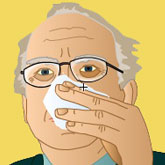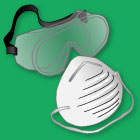Long acting relievers work on the lung tissue to relax it and open up the airways. They work for a long time so they are usually taken once or twice a day.
Please note there is no audio for this animation.
Long acting relievers work on the lung tissue to relax it and open up the airways. They work for a long time so they are usually taken once or twice a day.
Please note there is no audio for this animation.
Short acting relievers (bronchodilators) work on the lung tissue to relax it and open up the airways. They work for a short period of time to give relief from shortness of breath.
Please note there is no audio for this animation.
The main investigation for occupational asthma is your peak flow diary. You should do at least 4 peak flow tests spread throughout the day when you are at work and when you get home. The diary is kept for at least 3 consecutive days. It can be repeated when you are away from work on consecutive days to check for differences.
Some people with asthma may be given an Immunoglobulin E (Ig E) blood test which may show sensitivity to large dust particles.
Other lung function tests can be done in specialist hospitals. However, they will not always show a reaction even if you have a sensitivity to a work place irritant.
Sometimes a skin prick test is done for allergic reactions but many of the industrial causes for asthma cannot be tested using the skin prick method.
Often, there are symptom patterns and signs characteristic of occupational asthma when there is no other explanation for these symptoms.
| Likelihood of diagnosis increases if symptoms include two or more of these are mentioned: | ||||
|---|---|---|---|---|
| Wheezing or wheezy sounds in your chest. | Chest tightness. | Cough. | Shortness of breath. | Low forced expiratory flow in 1 second (FEV1) or reduced peak flow rate (British guidelines on management of asthma). |

![]()
Symptoms worsen while at work and improve or disappear when away from work.
Symptoms may also improve with inhaler treatment, but can improve without medication if irritant exposure is reduced.
Other symptoms:
The Health and Safety Executive is an independent watchdog for work-related health, safety and illness. Their website has a section about asthma at work which gives lists of occupations and irritants at work. It also gives information for you and your workplace about occupational asthma and work related asthma. There is also an asthma quiz to find out what you know about asthma at work.
Allergens and irritants are classified in high or low molecular weight, depending on their size.
Occupations which may trigger asthma include:
| Spray painter | Baker | Healthcare worker | Chemical worker |
|---|---|---|---|
| The isocyanides in spray paint may be a trigger. | The flour and grain dust in a bakery may trigger asthma. | Cleaning products and latex may be a trigger for asthma. | Chemicals (anhydrides) in the plastic and drug industries are a potential trigger for asthma, as are antibiotics. |
| Animal handler | Food processor | Welder | Timber worker |
| Animal dander (microscopic skin, fur and saliva) may be a irritant for asthma. | Food additives and colourings may also be a trigger. | Welding fumes can be an asthma trigger. | Wood dust may be an asthma irritant. |
This list is not exhaustive and other jobs may trigger asthma.
Pollen

Protective clothing
Smoking
| Occupational | |
|---|---|
| Delayed allergic | Susan is a hairdresser who has been working for three years. Her asthma has gradually got worse. She has been using many different hair dyes and this is the cause of her delayed reaction. She is now thinking of changing her job or asking her boss if she can avoid doing hair dying in future. |
| Immediate Non allergic Reactive Airways Dysfunction Syndrome (RADS) |
John is training as an apprentice plumber. His asthma has flared up since he started three months ago. This is partly due to the amount of extra physical work he is now doing and partly due to the symptoms associated with Reactive Airways Dysfunction Syndrome (RADS). RADS:
|
| Work aggravated | |
| Pre existing asthma + work aggravated | Mark had asthma as a child but he has had no asthma attacks since he was a teenager. He started working in a food processing factory a few weeks ago and suddenly his asthma symptoms have returned. After seeing his GP and following some tests at the local hospital he has found out that he is hyper sensitive to some of the food colourings used at work. He may have to change jobs within the factory to avoid contacts with the food colourings. |
| Pre existing asthma + work aggravated + occupational asthma | Jane is working as a part time nurse. She has had asthma since childhood and she has been successfully managing her asthma. Recently she changed her job on the same ward from part time to full time work. This involves 12 hour shifts which are more physically demanding. At the same time a new antibacterial cleaner is being used on the ward. A combination of the’ new cleaning materials used on the ward and the increased effort required in her new shift pattern has triggered the worsening of her previously well controlled asthma. After seeing her GP she is referred to the occupational health department in the hospital. They work with her respiratory team to find a solution to Jane’s working environment, symptoms and treatment. |